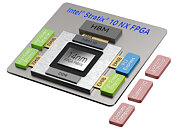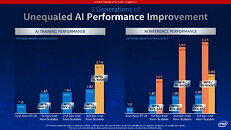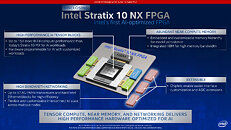- Joined
- Oct 9, 2007
- Messages
- 47,511 (7.48/day)
- Location
- Hyderabad, India
| System Name | RBMK-1000 |
|---|---|
| Processor | AMD Ryzen 7 5700G |
| Motherboard | ASUS ROG Strix B450-E Gaming |
| Cooling | DeepCool Gammax L240 V2 |
| Memory | 2x 8GB G.Skill Sniper X |
| Video Card(s) | Palit GeForce RTX 2080 SUPER GameRock |
| Storage | Western Digital Black NVMe 512GB |
| Display(s) | BenQ 1440p 60 Hz 27-inch |
| Case | Corsair Carbide 100R |
| Audio Device(s) | ASUS SupremeFX S1220A |
| Power Supply | Cooler Master MWE Gold 650W |
| Mouse | ASUS ROG Strix Impact |
| Keyboard | Gamdias Hermes E2 |
| Software | Windows 11 Pro |
Intel today introduced its 3rd Gen Intel Xeon Scalable processors and additions to its hardware and software AI portfolio, enabling customers to accelerate the development and use of AI and analytics workloads running in data center, network and intelligent-edge environments. As the industry's first mainstream server processor with built-in bfloat16 support, Intel's new 3rd Gen Xeon Scalable processors makes artificial intelligence (AI) inference and training more widely deployable on general-purpose CPUs for applications that include image classification, recommendation engines, speech recognition and language modeling.
"The ability to rapidly deploy AI and data analytics is essential for today's businesses. We remain committed to enhancing built-in AI acceleration and software optimizations within the processor that powers the world's data center and edge solutions, as well as delivering an unmatched silicon foundation to unleash insight from data," said Lisa Spelman, Intel corporate vice president and general manager, Xeon and Memory Group.





AI and analytics open new opportunities for customers across a broad range of industries, including finance, healthcare, industrial, telecom and transportation. IDC predicts that by 2021, 75% of commercial enterprise apps will use AI1. And by 2025, IDC estimates that roughly a quarter of all data generated will be created in real time, with various internet of things (IoT) devices creating 95% of that volume growth.
Unequaled Portfolio Breadth and Ecosystem Support for AI and Analytics
Intel's new data platforms, coupled with a thriving ecosystem of partners using Intel AI technologies, are optimized for businesses to monetize their data through the deployment of intelligent AI and analytics services.
Enhanced Intel Select Solutions Portfolio Address IT's Top Requirements: Intel has enhanced its Select Solutions portfolio to accelerate deployment of IT's most urgent requirements highlighting the value of pre-verified solution delivery in today's rapidly evolving business climate. Announced today are 3 new and 5 enhanced Intel Select Solutions focused on analytics, AI and hyper-converged infrastructure. The enhanced Intel Select Solution for Genomics Analytics is being used around the world to find a vaccine for COVID-19 and the new Intel Select Solution for VMware Horizon VDI on vSAN is being used to enhance remote learning.
The 3rd Gen Intel Xeon Scalable processors and Intel Optane persistent memory 200 series are shipping to customers today. In May, Facebook announced that 3rd Gen Intel Xeon Scalable processors are the foundation for its newest Open Compute Platform (OCP) servers, and other leading CSPs, including Alibaba, Baidu and Tencent, have announced they are adopting the next-generation processors. General OEM systems availability is expected in 2H 2020. The Intel SSD D7-P5500 and P5600 3D NAND SSDs are available today. And the Intel Stratix 10 NX FPGA is expected to be available in the 2H 2020.



Complete Slide Deck









































View at TechPowerUp Main Site
"The ability to rapidly deploy AI and data analytics is essential for today's businesses. We remain committed to enhancing built-in AI acceleration and software optimizations within the processor that powers the world's data center and edge solutions, as well as delivering an unmatched silicon foundation to unleash insight from data," said Lisa Spelman, Intel corporate vice president and general manager, Xeon and Memory Group.





AI and analytics open new opportunities for customers across a broad range of industries, including finance, healthcare, industrial, telecom and transportation. IDC predicts that by 2021, 75% of commercial enterprise apps will use AI1. And by 2025, IDC estimates that roughly a quarter of all data generated will be created in real time, with various internet of things (IoT) devices creating 95% of that volume growth.
Unequaled Portfolio Breadth and Ecosystem Support for AI and Analytics
Intel's new data platforms, coupled with a thriving ecosystem of partners using Intel AI technologies, are optimized for businesses to monetize their data through the deployment of intelligent AI and analytics services.
- New 3rd Gen Intel Xeon Scalable Processors: Intel is further extending its investment in built-in AI acceleration in the new 3rd Gen Intel Xeon Scalable processors through the integration of bfloat16 support into the processor's unique Intel DL Boost technology. bfloat16 is a compact numeric format that uses half the bits as today's FP32 format but achieves comparable model accuracy with minimal (if any) software changes required. The addition of bfloat16 support accelerates both AI training and inference performance in the CPU. Intel-optimized distributions for leading deep learning frameworks (including TensorFlow and Pytorch) support bfloat16 and are available through the Intel AI Analytics toolkit. Intel also delivers bfloat16 optimizations into its OpenVINO toolkit and the ONNX Runtime environment to ease inference deployments.
- The 3rd Gen Intel Xeon Scalable processors (codenamed "Cooper Lake") evolve Intel's 4- and 8-socket processor offering. The processor is designed for deep learning, virtual machine (VM) density, in-memory database, mission-critical applications and analytics-intensive workloads. Customers refreshing aging infrastructure can expect an average estimated gain of 1.9x on popular workloads and up to 2.2x more VMs compared with 5-year-old, 4-socket platform equivalents.
- New Intel Optane Persistent Memory: As part of the 3rd Gen Intel Xeon Scalable platform, the company also announced the Intel Optane persistent memory 200 series, providing customers up to 4.5 TB of memory per socket to manage data intensive workloads, such as in-memory databases, dense virtualization, analytics and high-powered computing.
- New Intel 3D NAND SSDs: For systems that store data in all-flash arrays, Intel announced the availability of its next-generation high-capacity Intel 3D NAND SSDs, the Intel SSD D7-P5500 and P5600. These 3D NAND SSDs are built with Intel's latest triple-level cell (TLC) 3D NAND technology and an all-new low-latency PCIe controller to meet the intense IO requirements of AI and analytics workloads and advanced features to improve IT efficiency and data security.
- First Intel AI-Optimized FPGA: Intel disclosed its upcoming Intel Stratix 10 NX FPGAs, Intel's first AI-optimized FPGAs targeted for high-bandwidth, low-latency AI acceleration. These FPGAs will offer customers customizable, reconfigurable and scalable AI acceleration for compute-demanding applications such as natural language processing and fraud detection. Intel Stratix 10 NX FPGAs include integrated high-bandwidth memory (HBM), high-performance networking capabilities and new AI-optimized arithmetic blocks called AI Tensor Blocks, which contain dense arrays of lower-precision multipliers typically used for AI model arithmetic.
Enhanced Intel Select Solutions Portfolio Address IT's Top Requirements: Intel has enhanced its Select Solutions portfolio to accelerate deployment of IT's most urgent requirements highlighting the value of pre-verified solution delivery in today's rapidly evolving business climate. Announced today are 3 new and 5 enhanced Intel Select Solutions focused on analytics, AI and hyper-converged infrastructure. The enhanced Intel Select Solution for Genomics Analytics is being used around the world to find a vaccine for COVID-19 and the new Intel Select Solution for VMware Horizon VDI on vSAN is being used to enhance remote learning.
The 3rd Gen Intel Xeon Scalable processors and Intel Optane persistent memory 200 series are shipping to customers today. In May, Facebook announced that 3rd Gen Intel Xeon Scalable processors are the foundation for its newest Open Compute Platform (OCP) servers, and other leading CSPs, including Alibaba, Baidu and Tencent, have announced they are adopting the next-generation processors. General OEM systems availability is expected in 2H 2020. The Intel SSD D7-P5500 and P5600 3D NAND SSDs are available today. And the Intel Stratix 10 NX FPGA is expected to be available in the 2H 2020.



Complete Slide Deck









































View at TechPowerUp Main Site







